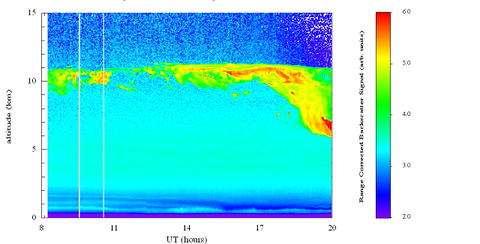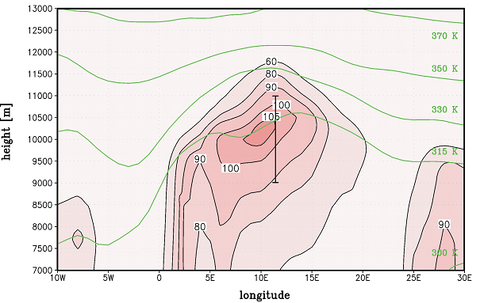Cirrus-LEWIZ - Cirrus clouds in polewared breaking Rossby waves
Aim
- observe cirrus clouds in poleward breaking Rossby waves with LIDAR
- characterised their pathway in the given synoptic situation using analysis data and backward trajectories
- develop a conceptual model for the transport of water vapor in poleward breaking Rossby waves
Organisation
- Principle investigator: Dieter H.W. Peters
- Contributors: Ronald Eixmann, Christoph Zülicke, Michael Gerding
- Runtime: January - July 2006
- Funding: IAP
Activities
- Launching of several field campaigns such as Cirrus-K1, Cirrus-K2 and Cirrus-K3 including radiosonde and LIDAR observations
- Review of "Historical LIDAR data"
Results
Poleward Rossby wave breaking events have been often observed over the North Atlantic - European region in the upper troposphere in winter time. During a measuring campaign from 13 to 15 February 2006 a special Rossby wave breaking event was investigated with radiosondes and LIDAR observations. The connected horizontal and vertical transport of water vapour in the upper troposphere / lower stratosphere was analysed with backward trajectories.
We found that during this poleward Rossby wave breaking event an air mass body has ben formed over central Europe with an extreme low temperature an a very high specific humidity in the tropopause region. The formation is characterised by a strong adiabatic nort-eastward and upward transport of water vapour on the western flank of a stagnation point over Mecklenburg (North German Lowlands). The radiosonde soundings show layers of supersaturated water vapour with respect to ice, but isolated patches of very high cirrus clouds have been clearly identified by LIDAR measurements over Kühlungsborn (54 °N, 11 °E). Based on formed LIDAR measurements from 1997 to 2002 and similar analysis we established the hypothesis that poleward Rossby wave breaking events are connected with north-eastward and upward tropospheric transport of water vapour, forming of supersaturated water vapour over ice and formation of very high cirrus clouds.
Thin-high cirrus clouds and LIDAR
The study K12 were with the LIDAR and high thin cirrus clouds within a anticyclonic air mass, which have remained virtually Mecklenburg observed. The transport of water vapor, the dynamic structures and the formation of cirrus clouds in these and other case studies, as these high cirrus clouds play an important role in radiation-budget (Eixmann, Peters, Zülicke & Gerding, ACPD 2008).
Publications
- Eixmann, R., D. Peters, Ch. Zülicke & M. Gerding, 2008: The upper tropospheric water vapour transport and observation of Cirrus clouds during poleward Rossby wave breaking events. in preparation.
Privatdozent Dr. habil. Dieter H.W. Peters
Tel. : +49 (0) 38293 68 380
Fax : +49 (0) 38293 68 50
















